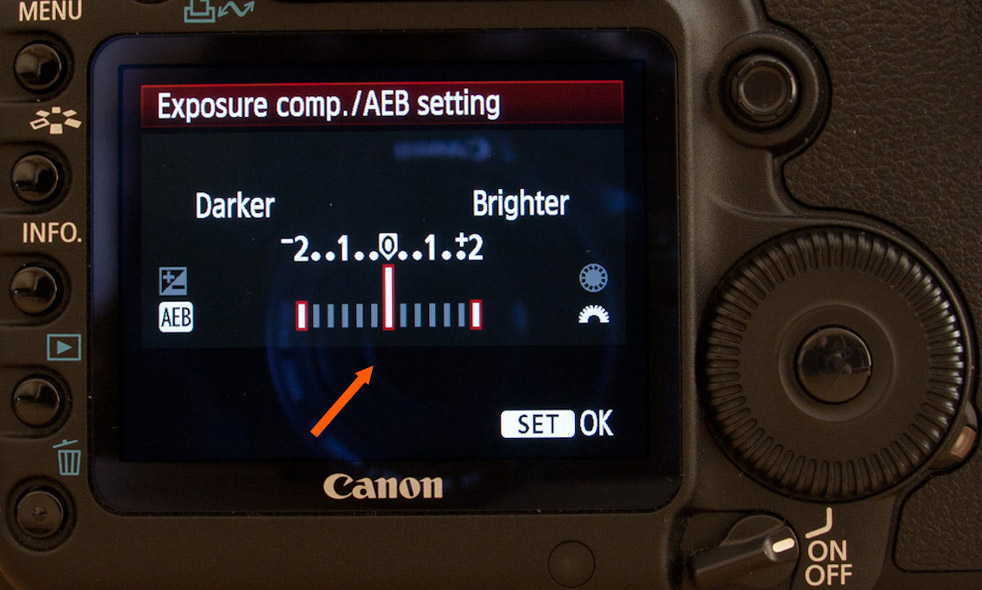Especially in HDR photography, and also on my blog, you may have seen EV being used quite often. And today, together we will look at what EV means, and how you use it.
EV – Exposure value
In the first part of this series, I talked about Exposure. As I explained, exposure is about how much light you let into your camera. Exposure value (EV) is any combination of shutter speed, aperture and ISO (some don’t include ISO, but I think it should be included) that yields the same exposure for a specific fixed amount of light.
On your camera, you will see a scale with 0 in the middle, mostly going from -2 to 2 or from -3 to 3. This shows the current EV value.
 If the value is shown as 0EV, this means, that the set settings for shutter speed, aperture and ISO together allow for an exposure, that is correct based on the cameras own metering of the current scene. If the EV is a negative number, that means that the resulting photo will be underexposed, if it’s a positive number, it will be overexposed. There are no specific settings for 0EV, as it changes based on available light, camera mode, lens and what from the three values you have changed yourself.
If the value is shown as 0EV, this means, that the set settings for shutter speed, aperture and ISO together allow for an exposure, that is correct based on the cameras own metering of the current scene. If the EV is a negative number, that means that the resulting photo will be underexposed, if it’s a positive number, it will be overexposed. There are no specific settings for 0EV, as it changes based on available light, camera mode, lens and what from the three values you have changed yourself.
When you take 0EV as the amount of light you need the capture for proper exposure, than +1EV is double the light, +2EV is four times the light and so on. -1EV is half the light captured, -2EV is quarter and so on. So the amount always doubles or half’s, based on which way you go. EV can also be set in fractions, like 1/3rd, 2/3rd’s. On some cameras you can switch this to use half’s.
To double the light, so going one stop up, you either double the time, double the ISO or double the aperture. This is easy to count for shutter speed and ISO, where you just double the number. For aperture, this is not so straightforward and an aperture table is needed. For instance to double F8 you go to F5.6, to double F5.6 you go to F4 and so on. But since every-time you change any of these values on your camera, they change by 1/3rd EV. So if you change the value three times, it will change by 1EV.
For instance, if you shoot in the Aperture priority mode, and you have a scene where f2.8, ISO 100 and 1/10s will result in correct exposure, that is 0EV, than also f2.8, ISO 200 and 1/20s will give the same result, f.4, iso 100, 1/5s, and so on. Each time you change one value, one of the other two has to change to compensate, for the EV to stay at 0.
Exposure compensation
First use for EV and their understanding is Exposure compensation. It probably happened to you, that you have been shooting in a certain conditions (snow covered landscape is a perfect example here) and all you photos came out too bright or too dark. Thats because your camera has problem determining the correct exposure. In this case you can compensate for this, by forcing the camera to take a positive or negative value EV instead of the 0 one.
So for instance, the mentioned snow example, cameras tend to underexpose in those situations. So by setting the exposure compensation to +1/3EV or higher, you will force the camera to overexpose every photo, so compensating for the problem.

Using exposure compensation is different on every camera, but mostly there is a wheel you turn to do so in the menu, or there is a specific wheel with EV markings on it. These have no effect in the Manual mode, as there you have to compensate manually by changing the aperture, shutter speed and ISO values.
Exposure bracketing
Exposure bracketing, is taking (or setting the camera to take) multiple photos with different EV values. For instance you can take a series of 5 photos, at -2EV, -1EV, 0EV, +1EV and +2EV.
This is for instances, where you know, that not everything will be exposed in the 0EV photo properly. Again, a typical example would be having a bright sky on half of the picture. Either your scenery, or your sky is properly exposed, but usually not both. Having multiple photos with different exposures, will endure you, that you have one with properly exposed sky and one with scenery. With those, you can then continue as you need, blend them, use HDR or similar.

And advance mode would be just to manually bracket for the EV values you need, and not even do the whole series.
You can take a look at my article about taking brackets for HDR, where I also included a video that shows exposure bracketing.
All the exact exposure values can be also calculated using mathematical equations, but I don’t think you will ever need it in the field. When taking photos the camera doest that for you :)


